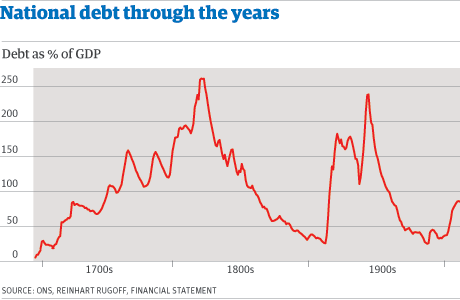nef and the Tax Justice Network have paired up top economists and journalists to write a series of guides exploring the truth behind common economic myths. The first mythbuster, prepared by Howard Reed and Tom Clark, addresses the question: is Britain really ‘broke'?
The answer is, of course, that the UK is very far from being broke. As Howard and Tom put it in the Guardian version of the article:
The defining narrative remains that There Is No Alternative, because Britain is "broke". But can this story be squared with the facts?
The figure below shows that UK debt/GDP was above 80% for most of the last 300 years. Enthusiasts for austerity tend to ignore the vast majority of that timeframe, focusing on the increase in debt from below 40% to around 80% of GDP in the last few years. But If Britain is broke at the moment, then the graph shows that it was also broke for a whole century between 1750 and 1850, and for 20 years after the second world war. In reality, in neither case did the UK default, and reveal itself as bust — both periods were times of investment, growth and national renewal.

Graphic - UK GDP since 1692
Other advocates of austerity suggest Britain is broke because the cost of servicing debt is bankrupting us. However, UK debt interest payments are now actually lower as a share of GDP than at any point up to the year 2000. So if this is the yardstick for being "broke", Britain has also been broke over the whole second half of the 20th century.
The simple fact is that the claim made is a myth, and that is what the whole series is about.
Mine comes in a few weeks time.
Thanks for reading this post.
You can share this post on social media of your choice by clicking these icons:
You can subscribe to this blog's daily email here.
And if you would like to support this blog you can, here:



The church report into Myths about the poor also indicates that the Welfare level has remained constant for the last 20 years and was even higher (as % of GDP) in 1982. This may have had something to to with the Thatcher administration ‘massaging’ the unemployment figures by encouraging people onto the then generous levels of incapacity benefit.
The British public, however, is sinking further into a Daily Mail induced trance.
The trouble is, the “public” don’t like the ‘Church’, it probably feels some hostility towards it, at some level.
Where have all these esteemed types been all this time? Have they been advised not to coordinate opinion? Surely we are talking about the keenest minds in the Christian society?
Unfortunately for those that do have a genuine faith, that system is as corrupted as the quasi-free marketeers that spit their bible with the brimstone etc.
And they do, like fanatics, and they think they’re funny, to boot.
There cannot be any directed revolution to encompass the general ill-ease, but where are the Crusaders?